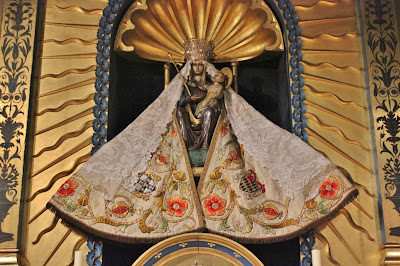Shrine of Our Lady of Walsingham
One of the holiest places in England is of course the Shrine of Our Lady of Walsingham in Norfolk, "England's Nazareth" - the title derives from the belief that Mary appeared in a vision to Richeldis de Faverches, a devout English noblewoman, in 1061, she had a holy house built for the Blessed Virgin Mary and the site became a shrine and a place of pilgrimage. The Holy House was a copy of the home in which the Annunciation occurred and it was built under the reign of Saint Edward the Confessor. The shrine eventually became an Abbey Church and the Augustinian Canons took care of it. Later in the Middle Ages the shrine became a central place of pilgrimage together with Canterbury and Glanstonsubury, when due to wars and political upheaval Rome became a difficult place to reach. The house was subject to Royal patronage since the time of Henry III and was also a place of pilgrimage for the Queens, first among all: Catherine of Aragon.
Walsingham priory was suppressed in 1538,
under the supervision of Sir Roger Townshend, a local landowner, Walsingham was
loved and its fall became symbolic. The buildings were looted and largely
destroyed, but the memory of it was less easy to eradicate. Sir Roger wrote to
Cromwell in 1564 that a woman of nearby Wells (now called Wells-Next-The-Sea),
had declared that a miracle had been done by the statue after it had been
carried away to London. He had the woman put in the stocks on market day to be
abused by the village folk but concluded "I cannot perceyve but the seyd
image is not yett out of the sum of ther heddes."
In the 20th century Walsingham saw the
restoration of the pilgrimage to the shrine of Our Lady. Today there are both
Anglican and Roman Catholic shrines. After nearly four hundred years the 20th
century saw the restoration of pilgrimage to Walsingham as a regular feature of
Christian life in the British Isles and beyond.
Father Alfred Hope Patten SSC, appointed as
the Church of England Vicar of Walsingham in 1921, showed a great interest in
the pre-Reformation pilgrimage. His idea was to recreate a new statue of Our
Lady of Walsingham based on the seal of the medieval priory. In 1922 the statue
was set up and from that first night the church became again a popular site of
pilgrimage.
Throughout the 1920s the number of pilgrims increased and in 1931, a new Holy House encased in a small pilgrimage church was dedicated and the statue translated there with great solemnity. In 1938 that church was enlarged to form the Anglican Shrine of Our Lady of Walsingham.
Throughout the 1920s the number of pilgrims increased and in 1931, a new Holy House encased in a small pilgrimage church was dedicated and the statue translated there with great solemnity. In 1938 that church was enlarged to form the Anglican Shrine of Our Lady of Walsingham.










